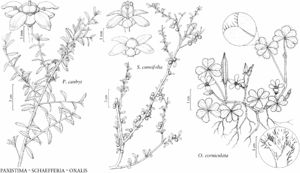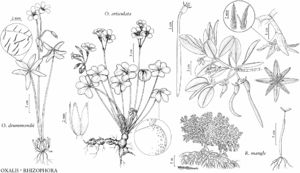Difference between revisions of "Oxalidaceae"
FNA>Volume Importer |
FNA>Volume Importer |
||
| Line 42: | Line 42: | ||
|publication year= | |publication year= | ||
|special status= | |special status= | ||
| − | |source xml=https://jpend@bitbucket.org/aafc-mbb/fna-data-curation.git/src/ | + | |source xml=https://jpend@bitbucket.org/aafc-mbb/fna-data-curation.git/src/f50eec43f223ca0e34566be0b046453a0960e173/coarse_grained_fna_xml/V12/V12_187.xml |
}}<!-- | }}<!-- | ||
-->[[Category:Treatment]] | -->[[Category:Treatment]] | ||
Revision as of 19:51, 16 December 2019
Herbs [subshrubs, shrubs, vines or trees], annual or perennial. Leaves alternate or whorled, usually palmately or pinnately compound, sometimes 1-foliolate; stipules usually present, rarely apparently absent; petiole present; blade margins entire; venation pinnate or subpalmate. Inflorescences terminal or axillary, cymes or racemes, or flowers solitary. Flowers bisexual, perianth and androecium hypogynous; hypanthium absent; sepals 5, distinct or slightly connate basally; petals 5, distinct or slightly connate basally; nectary present; stamens 10 in 2 whorls, connate basally (monadelphous), free; anthers dehiscing by longitudinal slits; pistil 1, 5-carpellate, ovary superior, 5-locular; placentation axile; ovules (1–)3–8(–10) per locule, anatropous; styles 5, distinct; stigmas 5. Fruits capsules [berries], dehiscence loculicidal, often elastically. Seeds 1–10 per locule.
Distribution
North America, Mexico, West Indies, Central America, South America, Eurasia, Africa, Atlantic Islands, Indian Ocean Islands, Pacific Islands, Australia, introduced in Bermuda.
Discussion
Genera 5, species ca. 800 (1 genus, 36 species in the flora).
Oxalidaceae occurs mostly in the tropics and subtropics of both hemispheres but extends into temperate regions. Species of Averrhoa Linnaeus and Sarcotheca Blume are trees or shrubs, those of Dapania Korthals lianas; all have fleshy, baccate fruits. Species of Biophytum de Candolle and Oxalis are herbs, subshrubs, shrubs, or rarely vines with capsular fruits; Biophytum has even-pinnate leaves fascicled at the stem tips. Seeds of Oxalidaceae develop an elastic, translucent, arilliform epidermis that turns inside out, explosively ejecting them from the capsule (K. R. Robertson 1975).
Oxalis tuberosa Molina (oca or New Zealand yam), of Andean South America, is cultivated for its edible tubers. Averrhoa is widely cultivated in the tropics for its fruits, which are eaten fresh, used in drinks, or made into jelly and jam. Both species of Averrhoa [A. bilimbi Linnaeus (bilimbi or cucumber tree), A. carambola Linnaeus (starfruit or carambola)] are known only in cultivation or as escapes from cultivation.
Selected References
None.


